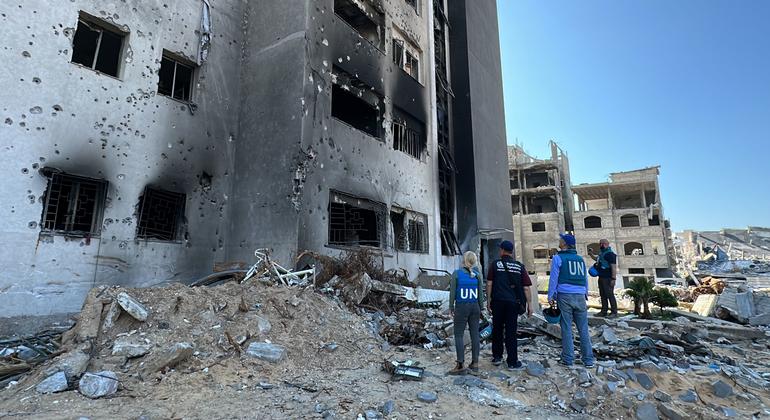Clearing Gaza’s Dangerous UXOs: A 14-Year Journey Ahead
 Making Gaza safe again from unexploded bombs could take 14 years, UN demining experts said on Friday.
Making Gaza safe again from unexploded bombs could take 14 years, UN demining experts said on Friday.
Pehr Lodhammar, a senior officer from the United Nations Mine Action Service (UNMAS), said that the war has left an estimated 37 million tonnes of debris.
He said it was impossible to determine the exact amount of unexploded ordnance in the enclave where formerly heavily built-up and densely populated neighbourhoods have been reduced to rubble, after nearly seven months of intense Israeli bombardment.
Every square metre in Gaza impacted by the conflict contains some 200 kilogrammes of rubble, the veteran UN demining expert told journalists in Geneva.
“All I can say is that at least 10 per cent of the ammunition that is being fired potentially fails to function…with 100 trucks we’re talking about 14 years of work with 100 trucks, so that’s 14 years to remove with about 750,000 workdays – person workdays – to remove the debris.”
Hostage release call to Hamas
The development came as the leaders of 18 nations including the United States called on Thursday for the release of all remaining hostages taken during the Hamas-led terror attacks in southern Israel that killed some 1,250 people.
Israel reportedly believes that more than 130 hostages are still being held in Gaza after the 7 October attacks which prompted the Israeli bombardment that has killed more than 34,350 Palestinians and wounded over 77,360, according to the enclave’s health authorities.
Famine threat remains
Meanwhile, UN humanitarians repeated warnings that famine is imminent in the northern Gaza Strip, in a renewed urgent appeal for more aid relief to be allowed into the enclave.
Israel pledged three weeks ago to improve aid access via the Erez Crossing just north of Gaza and Ashdod cargo port, further northwards. The UN World Food Programme (WFP) said that a small increase in aid had happened, but not nearly enough in volume – or diversity.
“We’re still heading towards a famine, we haven’t seen that paradigm shift that’s needed to avert a famine, we need more volume, more predictability and a sustained effort to get more diverse assistance into the north,” said Carl Skau, WFP Deputy Executive Director.
Amid reports of sustained Israeli strikes on eastern Rafah, Mr. Skau underlined continuing deep concerns that any ground invasion of the enclave’s southernmost city risked disrupting already insufficient aid distributions.
And turning to efforts to establish a marine corridor for humanitarian aid, the WFP official insisted that “there is no substitute for land” deliveries into Gaza.
Flotilla appeal
In a related development, top rights experts have appealed to Israel for safe passage for a flotilla of boats carrying humanitarian aid to Gaza.
The “Freedom Flotilla” plans to depart from Türkiye carrying 5,500 tonnes of aid, along with hundreds of international humanitarian observers, en route for the besieged Gaza Strip.
“As the Freedom Flotilla approaches Palestinian territorial waters off Gaza, Israel must adhere to international law, including recent orders from the International Court of Justice (ICJ) to ensure unimpeded access for humanitarian aid,” said the experts, who include Michael Fakhri, Special Rapporteur on the right to food.
In 2010, the experts noted that Israel intercepted and attacked the Freedom Flotilla’s civilian ships in international waters, killing 10 passengers and wounding many others.
At the time, the Freedom Flotilla had attempted to break the Israeli blockade by delivering humanitarian aid to Palestinians in Gaza.
Donate to the humanitarian response in Gaza
Elliot is an award-winning journalist passionate about international affairs and humanitarian causes. Elliot has covered stories from conflict zones and areas devastated by disasters, highlighting critical global issues.




A 14-year timeline to clear Gaza of unexploded ordnance is devastating. The immense scale of destruction and danger is a harsh reality that requires urgent global attention and action.
A devastating situation for Gaza. It’s appalling to think that it could take 14 years to clear all the unexploded bombs. The extensive destruction has left a massive amount of debris, making the cleanup process incredibly challenging. My heart goes out to the people living in such dangerous conditions.
Do you think the estimated 14-year timeline to clear Gaza from unexploded bombs is realistic given the magnitude of the task?
It’s heartbreaking to think that it could take 14 years to clear Gaza of these dangerous unexploded bombs. The scale of destruction and the long road ahead for recovery are truly daunting.